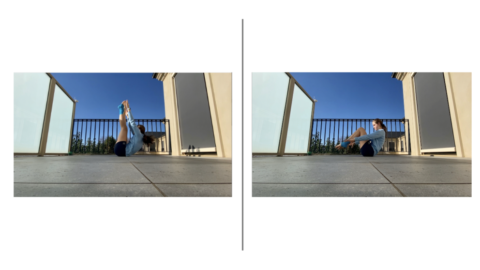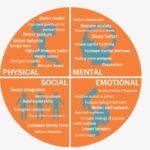From the Head of Health and Physical Education

Staying active is essential for physical and mental health and wellbeing. This is true no matter how young or old you are. The amount of activity varies however depending on age.
Keeping fit for mental and physical health has never been more pertinent than during lockdown restrictions and remote learning requirements, now and in 2020.
Staying Active Within the Curriculum, 2020
As reported in The Blue Ribbon in 2020, St Catherine’s Health and Physical Education Faculty developed Units of Study for all Years 7 to 10 students to create regular physical activity opportunities within their timetabled online lessons at home.
Through exploration of the Australian 24-hour Movement Guidelines for Youth, all students set their goals on achieving 60 minutes of moderate to vigorous physical activity every day, in conjunction with decreasing non-essential screen time.
Feedback from students was overwhelmingly positive, with students setting the task of developing their own seven-minute muscle and bone strengthening workout and a 20-minute cardio workout, to increase and maintain fitness levels, with theoretical concepts to develop health and physical activity literacy also involved.
2021 Fitness Approach – Take 5
Renown psychologist, Dr Michael Carr-Gregg, who recently presented at a Webinar attended by many in the St Catherine’s community, cites physical activity as one of the three building blocks to maintain optimal wellbeing, as well as a healthy diet and good sleep hygiene.
This year, with lockdown fatigue impacting us all and mental health issues increasing in Australians of all age groups, the Health and Physical Education Faculty has again implemented an online physical activity program within the Years 7 to 10 curriculum.
In Year 9, students are completing a fitness Unit of Study exploring health-related fitness components, including aerobic and anaerobic capacity and muscular strength and flexibility, with practical activities each lesson on the different components.
Other Year levels are participating in a ‘5 Option: Your Choice’ program, involving students selecting from a range of five options depending on how they are feeling that particular day.
Classes meet initially on Teams to discuss the lesson focus – such as the effect of exercise on the respiratory system or heart rate. After completing their choice of physical activity, students reconnect on Teams to reflect on the completed activity, providing short descriptors explaining the key features of their chosen activity, supported by images taken whilst participating.
Additionally, students evaluate the effectiveness of their physical activity session, in terms of achieving their desired outcome, how they felt during and after their activity and level of enjoyment. The categories include:
- Energy Burner – for those who are feeling constrained in lockdown and want to increase their heart rate with a full-body workout to burn energy. Options for this category include full-body workouts to music, Zumba and pacing yourself while running timed loops.
- Virtual Fitness – great for those that like following fitness regimes online, either individually or with friends, with a variety of links available to students on mystcatherines.
- Competitive Challenges – this category is for those who thrive on competition. Working out with friends online or within your household/family can be achieved in this challenge.
- Time for ‘Me’ – works well for those who might be lacking motivation and do not want to participate in intense physical activity. Activities include walking or cycling, participating in guided meditation online or practicing mindfulness.
- Learn Something New – this option can provide stimulation for your brain in conjunction with learning a new skill, like learning to juggle.
Support material and suggested links to activities are supplied on mystcatherines for all five categories, with feedback on this program being extremely encouraging. Both students and parents have commented on the benefits on health and wellbeing through reduced screen time and the facilitation of safe and purposeful physical activity.
For your interest, the 24-Hour Physical Activity, Sedentary Behaviour and Sleep Recommendations for ALL AGES are posted below.
Following the guidelines in the two tables below is associated with better body composition, cardiorespiratory and musculoskeletal fitness, cardiovascular and metabolic health, academic achievement and cognition, mental health and quality of life, emotional regulation and pro-social behaviours.
For optimal health, children and young people (five to 17 years) should achieve the recommended balance of high levels of physical activity, low levels of sedentary behaviour and sufficient sleep each day.
Summary of Guidelines by age – Children and Young People
| Recommendations | Under 12 months | 1 to 2 years | 3 to 5 years |
5 to 17 years
|
| Physical activity |
Interactive floor-based play and at least 30 minutes of tummy time for babies per day
|
At least 3 hours of energetic play per day | At least 3 hours per day, with 1 hour being energetic play |
At least 1 hour of moderate to vigorous activity involving mainly aerobic activities per day Vigorous activities should be incorporated at least 3 days per week Several hours of light activities per day |
| Strength |
At least 3 days a week
|
|||
| Sedentary time | Do not restrain for more than 1 hour at a time | Do not restrain for more than 1 hour at a time. |
Do not restrain for more than 1 hour at a time
|
Minimise and break up long periods of sitting |
| Sedentary recreational screen time | None |
Under 2 years: none 2 years: no more than 1 hour per day
|
No more than 1 hour per day | No more than 2 hours per day |
| Sleep | 0 to 3 months: 14 to 17 hours4 to 11 months: 12 to 16 hoursThis includes naps |
11 to 14 hours, including naps | 10 to 13 hours. Some will still need naps |
5 to 13 years: 9 to 11 hours 14 to 17 years: 8 to 10 hours |
Summary of Guidelines – Adults
| Recommendations |
18 to 64 years
|
Pregnancy | 65 years and over |
| Physical activity | Be active on most (preferably all) days to a weekly total of 2.5 to 5 hours of moderate activity or 1.25 to 2.5 hours of vigorous activity or an equivalent combination of both |
Be active on most (preferably all) days to a weekly total of 2.5 to 5 hours of moderate activity or 1.25 to 2.5 hours of vigorous activity or an equivalent combination of both Do pelvic floor exercises |
At least 30 minutes of moderate activity on most (preferably all) days |
| Strength | At least 2 days a week | At least 2 days a week | Do a range of activities that incorporate fitness, strength, balance and flexibility |
| Sedentary time | Minimise and break up long periods of sitting | Minimise and break up long periods of sitting |




